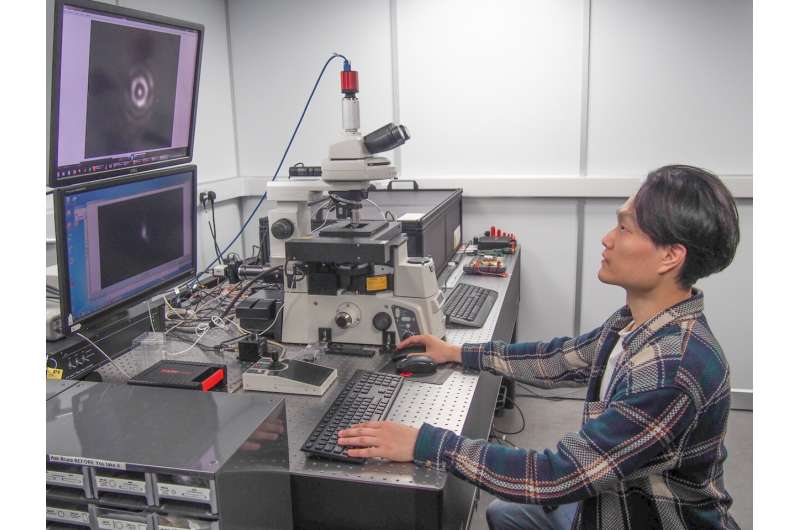May 19, 2023 feature
This article has been reviewed according to Science X's editorial process and policies. Editors have highlighted the following attributes while ensuring the content's credibility:
fact-checked
peer-reviewed publication
trusted source
proofread
Topologically structured light detects the position of nano-objects with atomic resolution

Optical imaging and metrology techniques are key tools for research rooted in biology, medicine and nanotechnology. While these techniques have recently become increasingly advanced, the resolutions they achieve are still significantly lower than those attained by methods using focused beams of electrons, such as atomic-scale transmission electron spectroscopy and cryo-electron tomography.
Researchers at University of Southampton and Nanyang Technological University have recently introduced a non-invasive approach for optical measurements with atomic-scale resolution. Their proposed approach, outlined in Nature Materials, could open exciting new possibilities for research in a variety of fields, allowing scientists to characterize systems or phenomena at the scale of a fraction of a billionth of a meter.
"Since the nineteen century, improvements of spatial resolution of microscopy has been a major trend in science that has been marked with at least seven Nobel Prizes," Nicolay I. Zheludev, one of the researchers who carried out the study told Phys.org. "Our dream was to develop technology that can detect atomic scale events with light, and we have been working on this for the last three years."
In their experiments, Zheludev and his colleagues demonstrated atomic scale metrology by collecting single-shot images of the diffraction pattern of topologically structured light with a wavelength of λ = 488 nm scattered on a suspended nanowire that was 17-μm-long and 200-nm-wide, to determine its position relative to the fixed edges of the sample.
The researchers then trained a deep learning algorithm on a dataset of single-shot images of scattering patterns that occurred when the nanowire was placed in 301 different positions. After training, this algorithm could predict the positions of a given nanowire based on the scattered light pattern recorded by the team's sensor.
"The main idea behind our approach is to use complex light structured at a very fine scale, the superoscillatory light containing singularities," Zheludev explained. "If a sub-wavelength object moves in such a field, the scattering pattern of light on the object is very sensitive to the shape and position of the object. We employ a form of artificial intelligence, a deep learning analysis of the scattered light intensity profile to reconstruct the object's position."
In the team's proof-of-principle experiments, their optical localization metrology method performed remarkably well, resolving the position of the suspended nanowire with a subatomic precision of 92 pm (i.e., around λ/5,300), while the nanowire naturally thermally oscillated with amplitude of ∼150 pm. For reference, a silicon atom is 220pm in diameter.
"Our most important achievement was to reach atomic scale resolution in detecting the position of nano-objects with light," Zheludev said. "We have achieved resolution that is thousands of times better than conventional microscopes can offer. Our work opens the field of picophotonics, the science of light-matter interactions on the picometer scale."
In their recent study, Zheludev and his colleagues demonstrated the potential of using optical metrology with topologically structured light to collect measurements on an atomic scale. In the future, the approach introduced in their paper could be used by other research teams worldwide to study subtle phenomena in greater detail and in non-invasive ways using light.
"We are now working on detecting picometer movements with a high frame rate, so we can shoot a video featuring the real dynamics of Brownian motion of a nanoscale object," Zheludev added.
More information: Tongjun Liu et al, Picophotonic localization metrology beyond thermal fluctuations, Nature Materials (2023). DOI: 10.1038/s41563-023-01543-y
Journal information: Nature Materials
© 2023 Science X Network





















